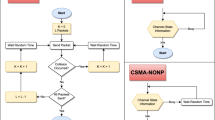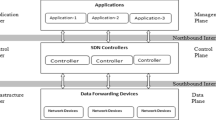Abstract
Video transmission over error-prone cognitive radio wireless networks is a challenging task. In much of the traditional tight admission control algorithms for video cognitive users (CUs) in cognitive networks, CUs are admitted sequentially based on the strict quality of service and interference constraints imposed on the cognitive and primary users respectively. The sequential admittance of CUs may impose some form of the queuing delay for time-sensitive CUs which may be unacceptable. On the other hand, traditional admission control schemes do not consider the quality of experience of video users for admitting newly incoming ones. For addressing these issues and obtaining a more flexible quality-centric admission control policy by which the admission system can admit eligible cognitive users in parallel, and to cope with uncertainties in the acceptable levels of the video quality for different CUs (which may use different softwares/hardwares with different capabilities) and interference levels imposed on the primary users, a soft admission control (SAC) technique (named FQAC) is proposed by which the admission probability level for the parallel CUs can intelligently be controlled based on some linguistic input variables. Numerical analysis has been performed to validate the efficiency of the proposed quality-centric SAC mechanism in sparse and dense networking scenarios.













Similar content being viewed by others
Notes
The MOS is a subjective measure for the perceived video quality [4].
In fact, the waiting time \(t_{i}\) is the time difference between the connection request time of a cognitive session \(i\) and the time it is admitted by the base station.
References
Fcc. (2002). Spectrum police task force report.
Jiang, H., Zhang, W., Shen, X., & Bi, Q. (2006). Quality of-service provisioning and efficient resource utilization in CDMA cellular communications. IEEE Selected Areas in Communications, 24, 4–15.
Fiedler, M., Hossfeld, T., & Tran-Gia, P. (2010). A generic quantitative relationship between quality of experience and quality of service. IEEE Network, 24, 36.
ITU-T Recommendation P.800. (1996). Methods for subjective determination of Transmission.
Joskowicz, J., & Ardao, J. C. L. (2012). A parametric model for perceptual video quality estimation. Telecommunication Systems, 49, 49–62.
Thu, Q. H., & Ghanbari, M. (2012). The accuracy of PSNR in predicting video quality for different video scenes and frame rates. Telecommunication Systems, 49, 35–48.
Igartua, M. A., Frías, V. C., de la Cruz Llopis, L. J., & Gargallo, E. S. (2012). Dynamic framework with adaptive contention window and multipath routing for video-streaming services over mobile ad hoc networks. Telecommunication Systems, 49, 379–390.
Ding, J. W., Deng, D. J., Lo, Y. K., & Park, J. H. (2013). Perceptual quality based error control for scalable on-demand streaming in next-generation wireless networks. Telecommunication Systems. doi:10.1007/s11235-011-9447-y.
Farahani, M., Ghasemi, A., & Razavizadeh, S.-M. (2010). Sequential interference-aware admission control in underlay cognitive radio networks. International Journal of Information and Communication Technology, 2, 33–40.
Le, L., & Hossain, E. (2008). Resource allocation for spectrum underlay in cognitive radio networks. IEEE Transactions on Wireless Communications, 7, 5306–5315.
Andersin, M., Rosberg, Z., & Zander, J. (1995). Gradual removals in cellular PCS with constrained power control and noise. In: IEEE PIMRC (pp. 56–60).
Zhang, L., Liang, Y., & Xin, Y. (2007). Joint admission control and power allocation for cognitive radio networks. In: IEEE ICASSP (pp. 673–676).
Gu, H., & Yang, C. (2008). Power and admission control for UWB cognitive radio networks. In: IEEE ICC (pp. 4933–4937).
Xiang, J., Zhang, Y., & Skeie, T. (2008). Joint admission and power control for cognitive radio cellular networks. In: IEEE ICCS (pp. 1519–1523).
Kim, D. I., Le, L. B., & Hossain, E. (2008). Joint rate and power allocation for cognitive radios in dynamic spectrum access environment. IEEE Transaction on Wireless Communications, 7, 5517–5527.
Nie, N., & Comaniciu, C. (2005) Adaptive channel allocation spectrum etiquette for cognitive radio networks. In: IEEE DySPAN.
Wang, B., Zhao, D., & Cai, J. (2010). Admission control and packet scheduling in a cognitive radio network with spectrum underlay. In: IEEE Globecom.
Alshamrani, A., Xie, L.-L., & Shen, X. (2010). Adaptive admission-control and channel-allocationpolicy in cooperative ad hoc opportunistic spectrum networks. IEEE Transactions on Vehicular Technology, 59(4), 1618–1629.
Jammeh, E., Mkwawa, I., Khan, A., Goudarzi, M., Sun, L., & Ifeachor, E. (2012). Quality of experience (QoE) driven adaptation scheme for voice/video over IP. Telecommunication Systems, 49, 99–111.
Shu, T., Krunz, M., & Vrudhula, S. (2006). Joint optimization of transmit power-time and bit energy efficiency in CDMA wireless sensor networks. IEEE Transactions on Wireless Communications, 5, 3109–3118.
Yates, R. D., & Goodman, D. J. (2004). Probability and stochastic processes, a friendly introduction for electrical and computer engineering, 2nd edition. New York: Wiley.
Kim, H. l., & Choi, S. G. (2010) A study on a QoS/QoE correlation model for QoE evaluation on IPTV service. In: The 12th International Conference on Advanced Communication Technology (ICACT).
ITU-T Recommendation G.1070. (2007). Opinion model for video-telephony applications.
Grandhi, S. A., & Zander, J. (1994). Constrained power control in cellular radio systems, In: IEEE VTC (pp. 824–828).
Andersin, M., Rosberg, Z., & Zander, J. (1997). Soft and safe admission control in cellular networks. IEEE Transactions on Networking, 5, 255–265.
Zadeh, L. (1965). Fuzzy sets. Information Control, 8, 338.
Takagi, T., & Sugeno, M. (1985). Fuzzy identification of systems and its applications to modeling and control. IEEE Transactions on Systems Man and Cybernetics, 15, 116–132.
Goudarzi, P. (2006). A ga-based fuzzy rate allocation algorithm. In: IEEE ICC.
Jang, J. S. R. (1993). ANFIS: Adaptive-network-based fuzzy inference systems. IEEE Transactions on Systems, Man, and Cybernetics, 23(3), 665–685.
The Network Simulator 2. www.isi.edu/nsnam/ns/.
Wang, Z., Lu, L., & Bovik, A. C. (2004). Video quality assessment based on structural distortion measurement. Signal Processing, 19, 121.
Author information
Authors and Affiliations
Corresponding author
Rights and permissions
About this article
Cite this article
Goudarzi, P. FQAC: a soft admission control scheme for high quality video delivery over cognitive radio wireless networks. Telecommun Syst 58, 67–80 (2015). https://doi.org/10.1007/s11235-014-9874-7
Published:
Issue Date:
DOI: https://doi.org/10.1007/s11235-014-9874-7




